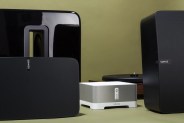Shoot the shit with any audiophile, and when Sonos comes up, they’ll have good things to say. The Santa Barbara–based speaker designer is well respected. But that hasn’t meant smooth sailing for the breakout brand.
A spike in the popularity of smart speakers like the Amazon Echo and Google Home, has hurt Sonos. So has the rise of higher-end speakers integrated with home wi-fi technologies like DTS Play-Fi and Google Chromecast. Sonos’s CEO of the last 14 years, John MacFarlane, even stepped down in early 2017 (to be replaced by Patrick Spence). In response to the market, future Sonos products are being designed with built-in microphones and compatibility with smart-home services from Amazon, Google and — potentially — Apple. But they aren’t there yet.
The Playbase ($699) is the first Sonos speaker released under the new order. It’s designed in the same minimalist vein as Sonos’s other speakers and it also works in the same way, via the Sonos app or Spotify. The Playbase sounds great, as one would expect, but it’s essentially the same product as Sonos’s four-year-old Playbar ($699). True, the Playbase has a little more power, with 10 drivers instead of the Playbar’s nine, but ultimately the biggest difference is its shape.
The Playbase sounds great, as you would expect, but it’s basically the same product as Sonos’s four-year-old Playbar.
The Playbase is a flat speaker designed to rest under your TV (as long as the TV weighs less than 75 pounds), whereas the Playbar is typically wall mounted. If your TV is mounted, the Playbase may look anomalous in your media setup. Both Playbase and Playbar are equal parts TV speaker and wireless music speaker. They’ll drastically improve the sound quality of your TV-viewing experience if you’ve gone without speakers on your TV for a while. (4K TVs look beautiful but don’t sound great; thinner TVs lack center channels.)
If you already own other Sonos speakers, you can group them with the Playbase or Playbar to merge everything into one multi-room system. This means if you’re a roaming TV watcher — the kind to walk from room to room while still listening to Jeopardy! — you can hear the TV from wherever, as long as your other rooms have Sonos speakers.
Neither Playbar nor Playbase comes with any Alexa-, Siri-, or Google-Assistant-enabled skills. Sonos has promised that all of its speakers will be compatible with Amazon Echo and Dot later this year, but an exact date hasn’t been confirmed. And unless you have a Sonos Connect ($349), you won’t be able to pair it with any other non-Sonos device.


